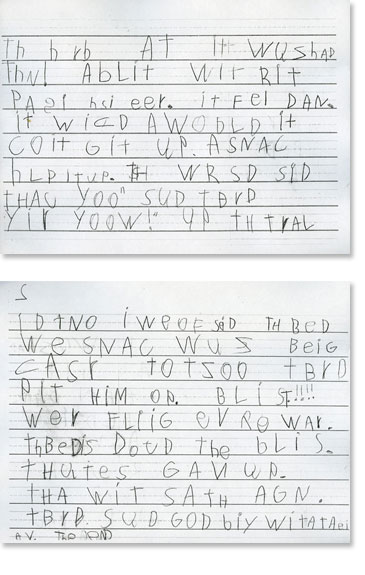Context of writing
A first grade boy wrote this story. After reading William Steig’s Amos and Boris, students were prompted to write a story with an unlikely friendship between two animal characters.
This child’s teacher describes the author as highly imaginative with a great vocabulary, but he has difficulty getting his words on paper. The author was not able to read his story back to his teacher right after he wrote it. He told his teacher he was frustrated because he had a story in his head and he didn’t know which parts he already written.
What is this child able to do as a writer?
- This child has drawn a picture with many details and has a detailed story in mind.
- He uses vivid word choice to create a picture for the reader (‘It wiggled and wobbled.’ ‘It couldn’t get up.’ ‘Blast!!’)
- He is using dialogue in his story and experimenting with the use of quotation marks.
- The way the author writes suggests he’s heard lots of stories. He’s trying to use story conventions such as ‘Up the trail they went.’

What does this child need to learn next?
This writer is full of complex ideas but cannot get them out clearly on paper with words. He has spelling deficits and difficulty sequencing his story. This makes it difficult for him to re-read what he has written. He often gets confused where he is in his story. This child could benefit from a storyboard for prewriting . He could use his talent and interest in drawing to carefully plan out his story with pictures in separate frames. Then, he could be shown how to take one frame at a time and write a sentence for that frame. That may help him remember where he is in his plot and help him sequence his story in a way that makes sense to both him and his reader.
A writing strategy that helps students form first paragraph uses a hamburger graphic to help them brainstorm an introduction, supporting information, and a conclusion. Students enjoy creating their own “hamburgers” with this strategy.
